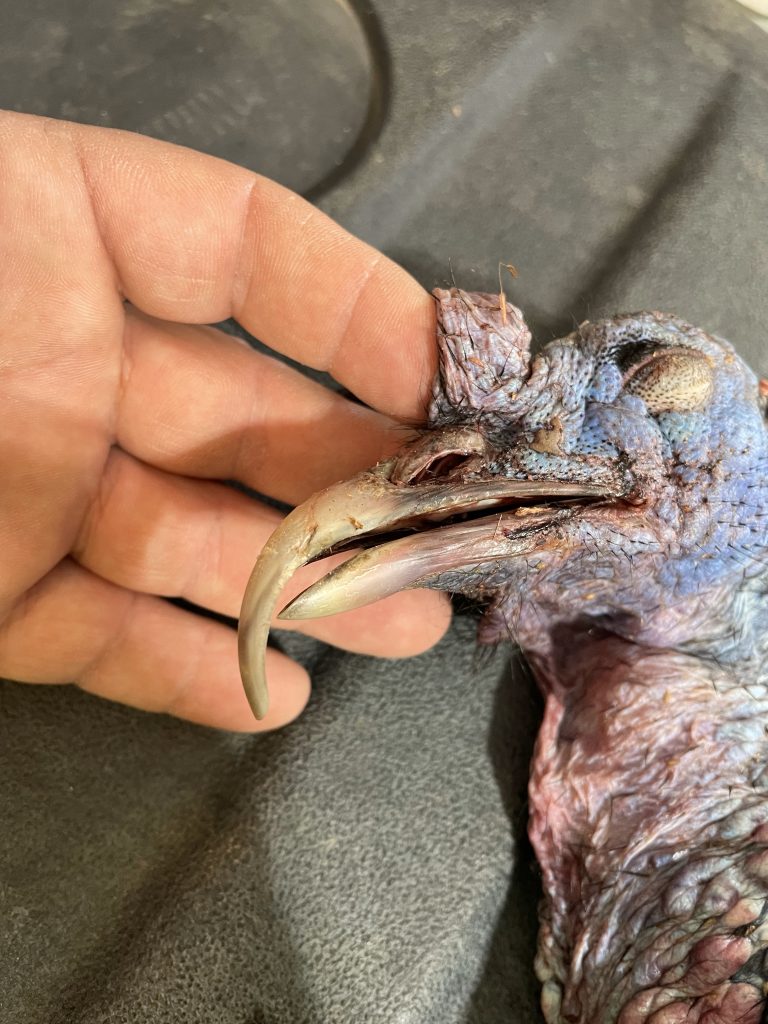Behemoth Beaks
Dr. Tom discusses misaligned wild turkey beaks and possible causes.
The beak of this gobbler looks strange. What do you think was going on with this gobbler?
— Kip Schneider, Mascoutah, Illinois

As you mentioned, the upper beak on your gobbler is much longer than normal. A couple of reasons for this condition are possible. Let me first discuss the uses and structure of wild turkey beaks. Ornithologists use the terms bill and beak interchangeably, but many of us who like to hunt generally talk about beaks when discussing game bids and birds of prey and use the term bill when referring to waterfowl.
Bird beaks perform a number of functions ranging from everyday feeding to fighting and courtship displays depending on the species involved. Bird beaks are seen with specializations depending on the birds’ food habits and needs. For example, the beaks of cardinals, grosbeaks and finches are strong and heavy because they are used to break open hard seeds. Heron and egret beaks are long and hard for grasping slippery fish. American woodcock and many shorebirds have long beaks for probing in soft earth to find worms and insects. Typically, wild turkeys use their beaks for pecking at food items, capturing insects, grasping food items, fighting and preening.
The upper beak is called the maxilla, the lower beak is the mandible. The outer surface of both the upper and lower beaks is composed of a thin layer of keratin called the rhamphotheca. The keratin arises from the epidermis (skin) and the keratin surface grows constantly. Generally, its growth is limited by everyday wear as the bird feeds and preens. In wild turkeys, the base of the maxilla can flex at the point where the upper beak attaches to the brain case known as the nasofrontal hinge. This enables the bird to open its beak wide enough to swallow acorns, hickory nuts and other large food items. As long as the upper and lower beak are properly aligned, normal wear and tear keeps the beak trimmed.
This gobbler’s lower beak appears to be normal. Therefore, it is likely that the upper beak is out of alignment and was allowed to increase in length despite typical wear. The cause of misalignment could be an injury to the nasofrontal hinge or a genetic trait that led to misalignment. Whatever the cause, the bird’s overall condition was unaffected. He was able to grow and mature, feeding, fighting and preening in a normal fashion. I have seen this condition in chickens and game-farm-reared ringneck pheasants, so it is not surprising that it occurs occasionally in wild turkeys. Though I have not encountered the condition in any of the wild turkeys I have banded, I have seen one or two other photos of turkeys with elongated upper beaks.
Thanks again for sharing your photo with us and congratulations on your success in the spring season!
Send your wild turkey questions, photos and videos to turkeycall@nwtf.net for Dr. Tom to answer. Check out more video answers from Dr. Tom by scanning the QR code.
CONNECT WITH US
National Wild Turkey Federation
770 Augusta Road, Edgefield, SC 29824
(800) 843-6983
National Wild Turkey Federation. All rights reserved.
